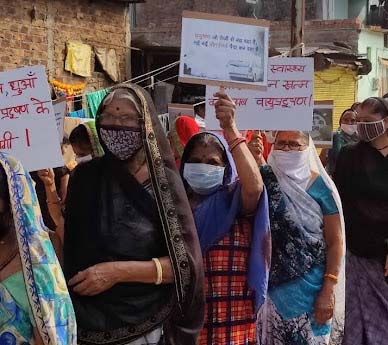A Moving Target: The variability in air quality and how to respond
December 22nd, 2021 | viewpoint
Air pollution, a problem around the world, is especially concerning in urban areas. Frequent exposure to air pollution is harmful, and pregnant women and children are more sensitive to these pollutants. There are many sources of air pollution that can interact with each other and other environmental factors to diminish air quality. These sources vary by location.
This variability makes air pollution a problem without a simple solution. The USAID-funded Building Healthy Cities (BHC) project believes the best way to control air pollution is by educating and empowering community members, and doing so in Indore, India. In partnership with Indore Smart City Development Limited, Indore School of Social Work, SkyMet, and TD Environmental Services, BHC has trained and continues to work with 20 community-based volunteers called clean air guides (CAGs) across the city. CAGs attended sessions where they learned about the levels, sources, and hazards of air pollution, as well as ways to improve air quality. The project also installed 20 low-cost air quality sensors in the CAGs’ communities. The sensors collect data on particulate matter (suspended dust particles) as a measure of air quality in the surrounding area.
These data, combined with knowledge from community members through interviews and public events, help the CAGs understand the biggest sources of pollution in their communities. For example, if a sensor shows a notable contrast between weekdays and weekends, the CAGs apply their knowledge of the area to hypothesize a cause, whether it be heavier traffic or more construction on weekdays, and then discuss these hypotheses with community members.
This short animation shows a snippet of the air quality data that BHC collected over the course of two weeks. It illustrates how air pollution can vary by location and day.
One sensor was placed in the Lunyiapura, a small neighborhood in the city near a crematorium. BHC originally chose the location to see how big of an effect the crematorium was having on the air quality. However, after talking with the Luniyapura CAG Jugal Kishore Chouhan, it was clear there were many more factors. In addition to the crematorium, train tracks run nearby and busy streets surround the neighborhood. Another compounding factor is that because mosquitoes are breeding in stagnant waste water in drains, residents burn mosquito coils. Because the air quality in Luniyapura is compromised by all of these factors, it is almost impossible to isolate and measure the effect of a particular source.
In addition to informing neighbors, the CAGs are helping them organize. In November, the Indore Municipal Corporation asked the CAGs and other local groups to participate in a city-wide air quality awareness walk. And Jugal Kishore Chouhan organized a rally in Luniyapura to raise awareness of air pollution on December 15.
 Although air pollution is literally a convoluted and moving target, citizen knowledge is the key to improving air quality across a city, country, and the world. When people have information and actionable recommendations, they can unite to control its sources.
Although air pollution is literally a convoluted and moving target, citizen knowledge is the key to improving air quality across a city, country, and the world. When people have information and actionable recommendations, they can unite to control its sources.
We strive to build lasting relationships to produce better health outcomes for all.